KAROO DREAMING
Battissian Reverie: A Fookian feast in Somerset East
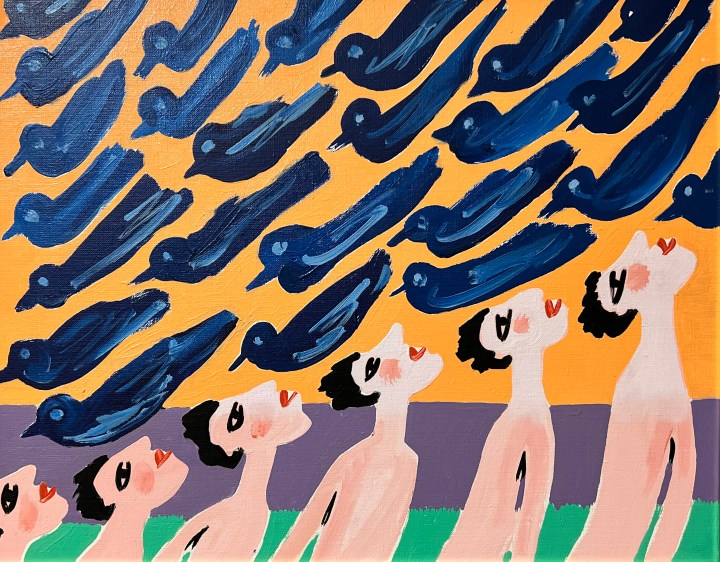
We’ve all gazed into a painting and got lost in it. With Walter Battiss, this can mean diving deep into the strange, strange world that the artist lived in. If you were me, you might even find yourself inventing a Fookian cuisine.
Imagine having your own island and currency. Your own language, even a font all your own. A passport issued by yourself, to yourself, which hoodwinks you through passport controls elsewhere in the world while you smile wryly beneath your flowing silver locks. A cloak of many colours to envelop you. A palette of many hues in your hand, and a brush poised. Welcome to the wonderful world of Walter Battiss.
When plotting a route through the Eastern Cape Karoo, or travelling between Gqeberha and parts further north on the N10 that links Johannesburg with the coast, or making a detour from Addo, build a foray to Somerset East into your plans. It’s only 24 km off the N10, less than half an hour, and compelling worlds await you there.
This is the most verdant part of the Karoo – it’s almost English in its green beauty – and at the foot of the Boschberg (Bosberg) beyond the avenue of ancient oaks that grace the little town lies a double-storey house which was once a private hotel operated by the artist’s parents. The oaks were planted by Battiss’s great grandfather. Right next door to lovely Paulet House, the Walter Battiss Art Museum captivates you for hours as you disappear into the eccentric milieu of this artist who lived in a world of his own, within our world. There’s something to be said for that, and we might all be happier if we were able to create our own mad little worlds.
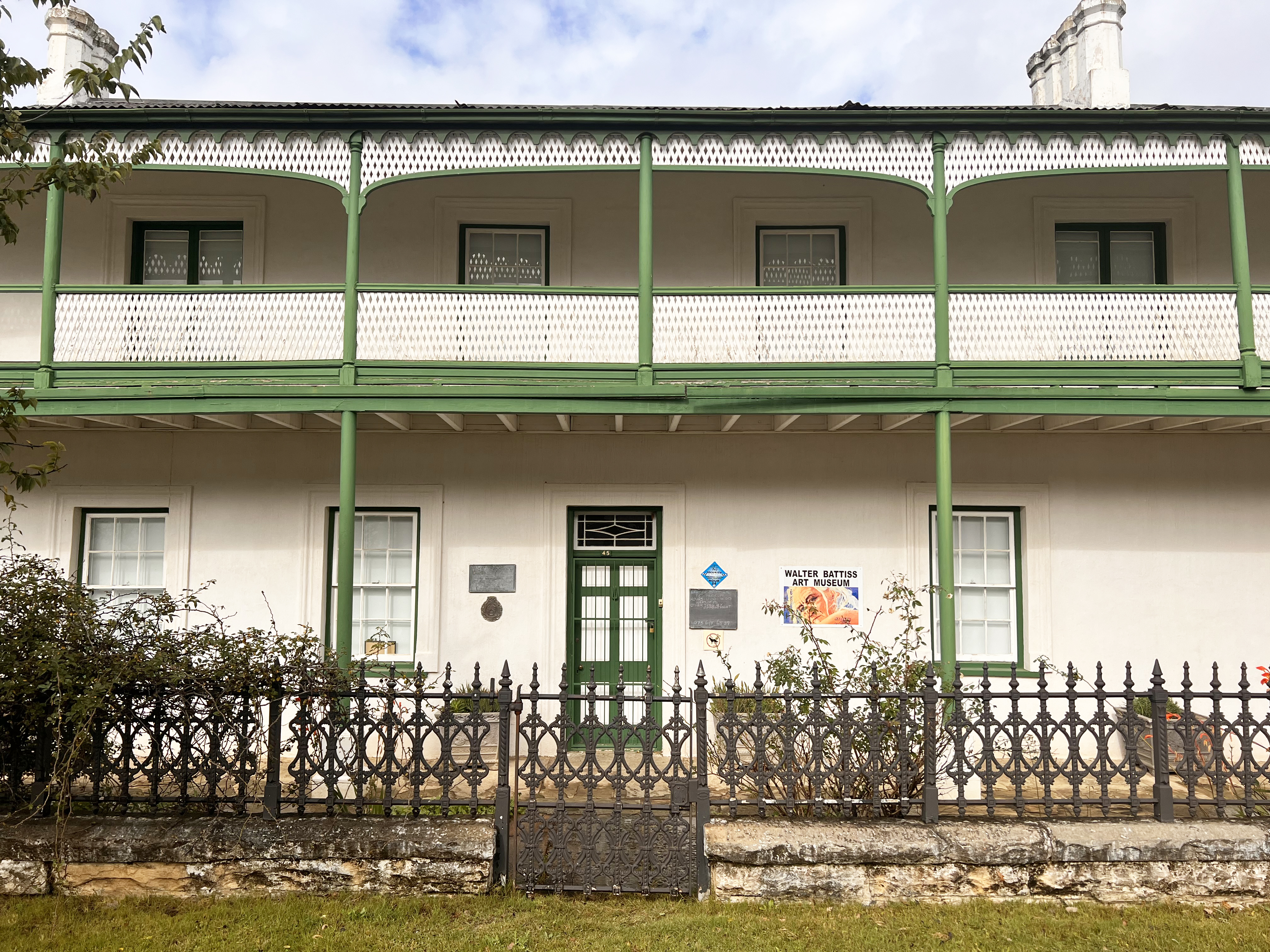
Entrance to the Walter Battiss Art Museum. (Photo: Tony Jackman)
Battiss, once described as “the gentle anarchist”, was born in this house in 1906, and it became the museum it is now in 1981, the year before his death from a heart attack in Port Shepstone. Massive restoration happened in the museum’s early days, and today it is a prime showcase of a great many of the artist’s works, though as the curator quickly points out, his output was massive, so despite the abundance of art here it is only a small part of his entire catalogue.
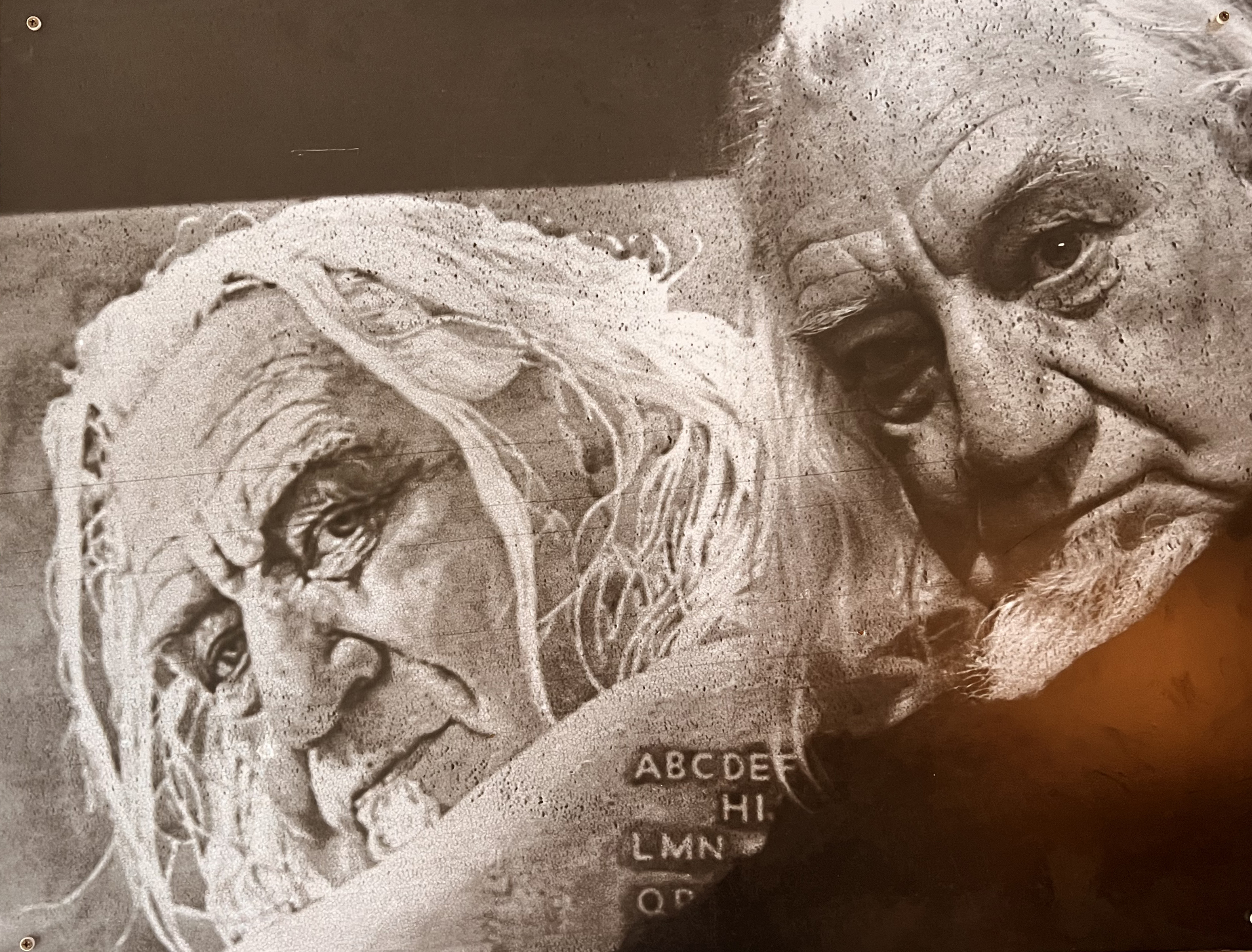
Portrait of an artist with his famous self-portrait. (Photo: Tony Jackman)
The bright-eyed, effervescent Australian-born curator, Ros Turner, has a winning way with the work she so eagerly shows off, genre upon genre of this wildly divergent artist’s works, including the colourful trappings of the “island of the imagination”, Fook, that he invented in collaboration with Norman Catherine, and all that went with his fantasy, from his painted banknotes, coins and postage stamps to an alphabet, a Fookian mythology, and the pair of cloaks worn by King Ferd III of Fook Island, even the Fook Island flag that ultimately would be draped over the artist’s coffin.
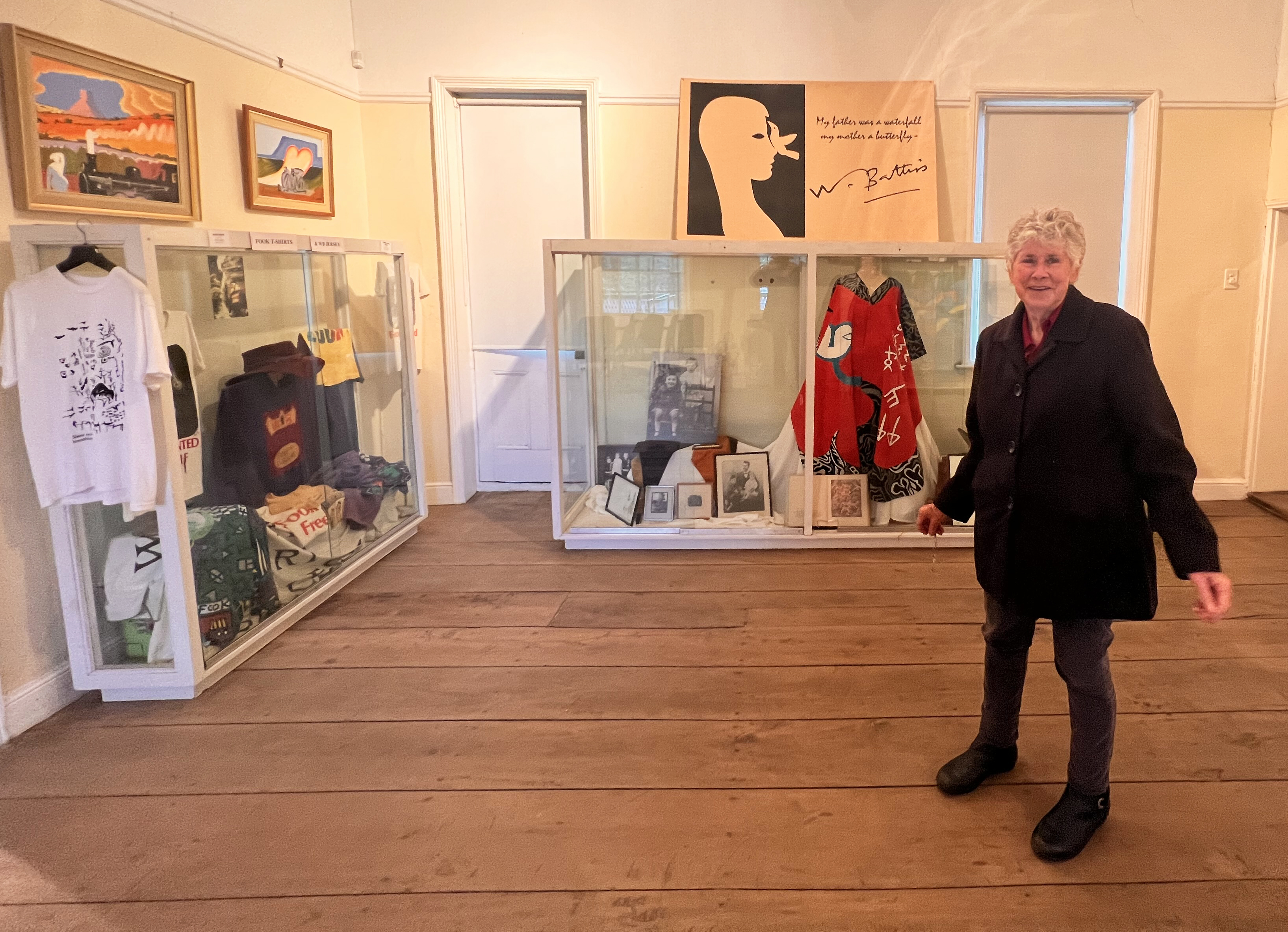
Ros Turner in her element with the King Ferd III cloaks in a display cabinet behind her. (Photo: Tony Jackman)
If you think, as one well might, that naming it Fook Island was a bit of an allusion to a similar Old English word (I suspect there was an element of that), what is believed to have happened is that Battiss was in London and opened a telephone directory in search of a name. Chancing on surnames beginning with F, he came across the (presumably Chinese) surname of Fook and thought, that will do.
Battiss’s friend Esmé Berman, one of the earliest Fookians, once wrote: “You will seek in vain for the location of the island, for it eludes conventional cartography. It is not a place you arrive at, you are either there or not there.” Lost in the artist’s watercolours, I slid into that world of the imagination, Fook Island revealing itself in the mists, as it does for those with the eyes to see. I drifted away into a Fookian paradise where strange fruit grows and the Fookois islanders glory in the freedom bestowed on them by their benign creator…
If I’d been born in an earlier time and privileged to have befriended Battiss, I’d have offered to develop a Fook Island cuisine and persuaded him to appoint me Fookian-Chef-in-Chief. I’d dub it Fookuisine, and it would be introduced to the island nation in a grand Fookesque feast, which all Fookois would be required to attend. If you can invent an island, a currency (the Fookois people trade in banknotes calls aks), and a passport that actually works (he quite literally travelled on it), there’s no reason not to invent your island’s own food culture too.
In my Battissian reverie, on the sun-kissed Fookian coast there’d be plantations of cananas and bobonuts, dangoes and waterlemons. (Read that word again, slowly.) Brightly-hued dishes would be garnished with purple pistachios and peppermint saffron, caramel sage and midnight blue thyme. Bowls of toasted viridian macadamias and roasted scarlet pecans would whet our appetite for the feasting to come.
On our brightly hued watercolour island, there would be a welling of excitement as Spring approached and we knew it was time for the Fook Island Festivities, known by some island wags as the Fookinalia, when every tree and dwelling would be garlanded in every hue of every Walter Battiss painting and the dress code would be don’t-bother. From the island nosh pit would emit wafts of carsimmon and roseradish smoke as the kitchen striplings tended spit roasts of wild doar and gabbit, bartridge and drancolin. At dusk on the eve of the great feast, grooms would be dispatched to capture 48 of the Fookawi birds that swoop over the heads of the Fookois islanders at sunset every day, to be simmered in sweet island spices and spoon-fed to their brides, following the traditional Fookinalian mass wedding.
Sturdy fookoors with their purple domes would be fired up for us to roast giant kebabs of the exotic fruits of the island’s psalm and crabshew trees. In giant vermilion cauldrons, stews of morthog and jostrich would bubble and burble, until nubile Fookazonian youths would arrive to bear great tureens on high to the drooling diners at endless imaginary tables.
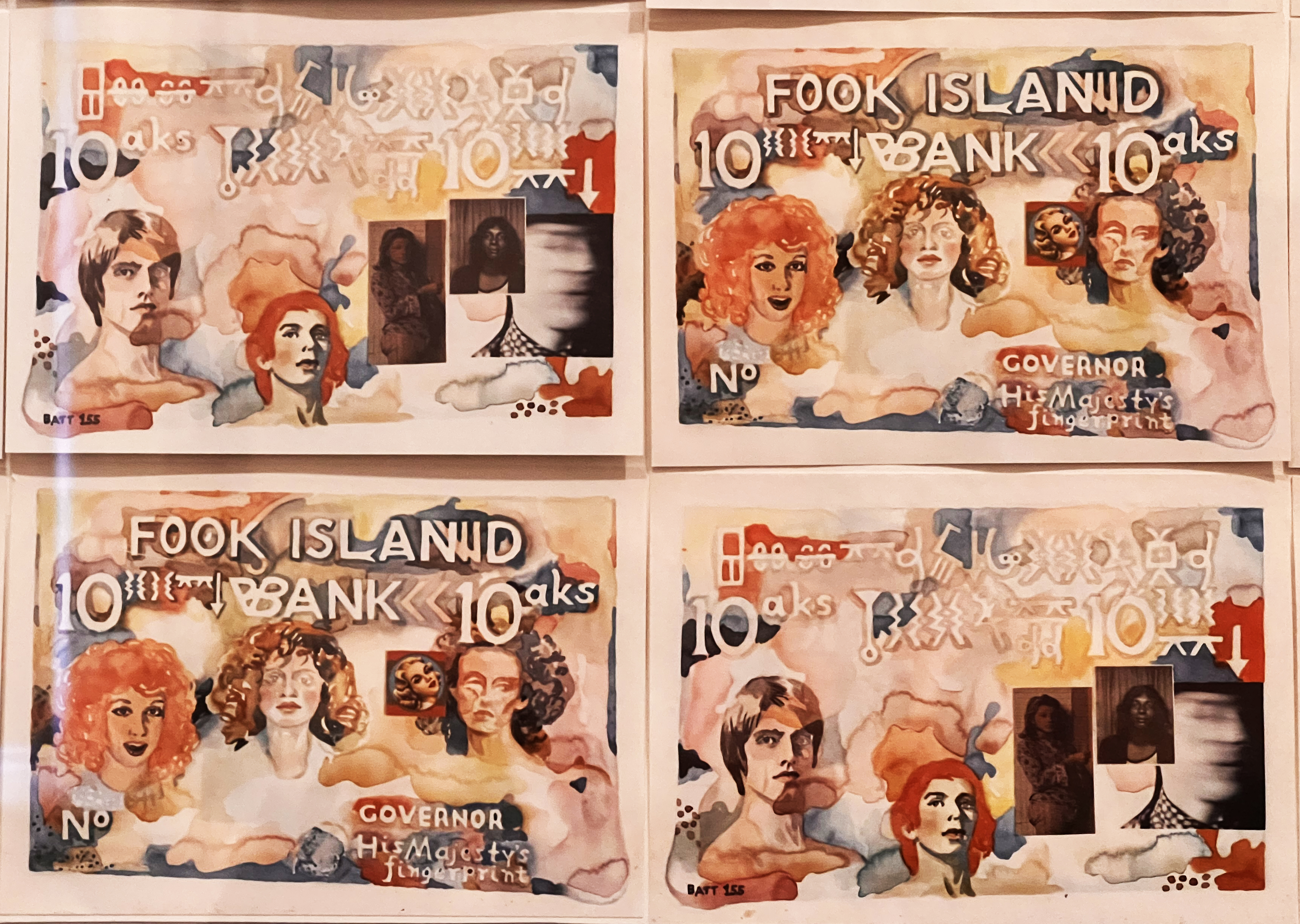
Fook Island banknotes, above, and stamps, below. (Photos: Tony Jackman)
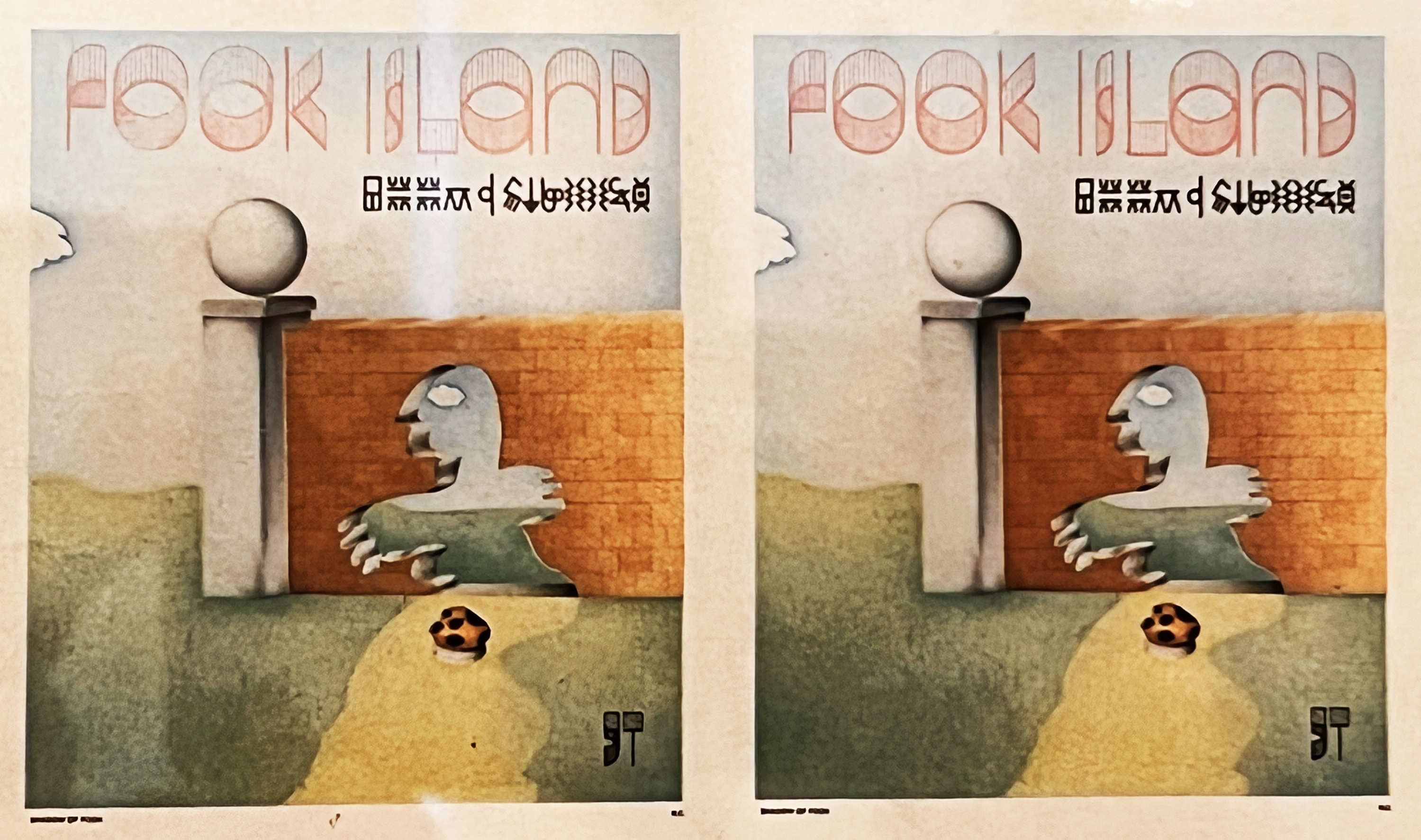 But reveries must dissipate, and there are worse places to come out of one than inside this museum. As happens with all eccentrics, not everybody understands quite who they are or approves of what they do. Arguably Battiss’s seminal work, and certainly the painting that Turner says is the finest in the museum’s collection, caused outrage when, in 1949/50, it was submitted as part of the South African entry for the 25th Venice Biennale. The abstract oil painting was even discussed in the South African Parliament and the artist was dismissed by at least one ignoramus as an “Unworthy Springbok” and the painting, Father and Son in the Rocks (1949), as “an unworthy representation of South African art”.
But reveries must dissipate, and there are worse places to come out of one than inside this museum. As happens with all eccentrics, not everybody understands quite who they are or approves of what they do. Arguably Battiss’s seminal work, and certainly the painting that Turner says is the finest in the museum’s collection, caused outrage when, in 1949/50, it was submitted as part of the South African entry for the 25th Venice Biennale. The abstract oil painting was even discussed in the South African Parliament and the artist was dismissed by at least one ignoramus as an “Unworthy Springbok” and the painting, Father and Son in the Rocks (1949), as “an unworthy representation of South African art”.
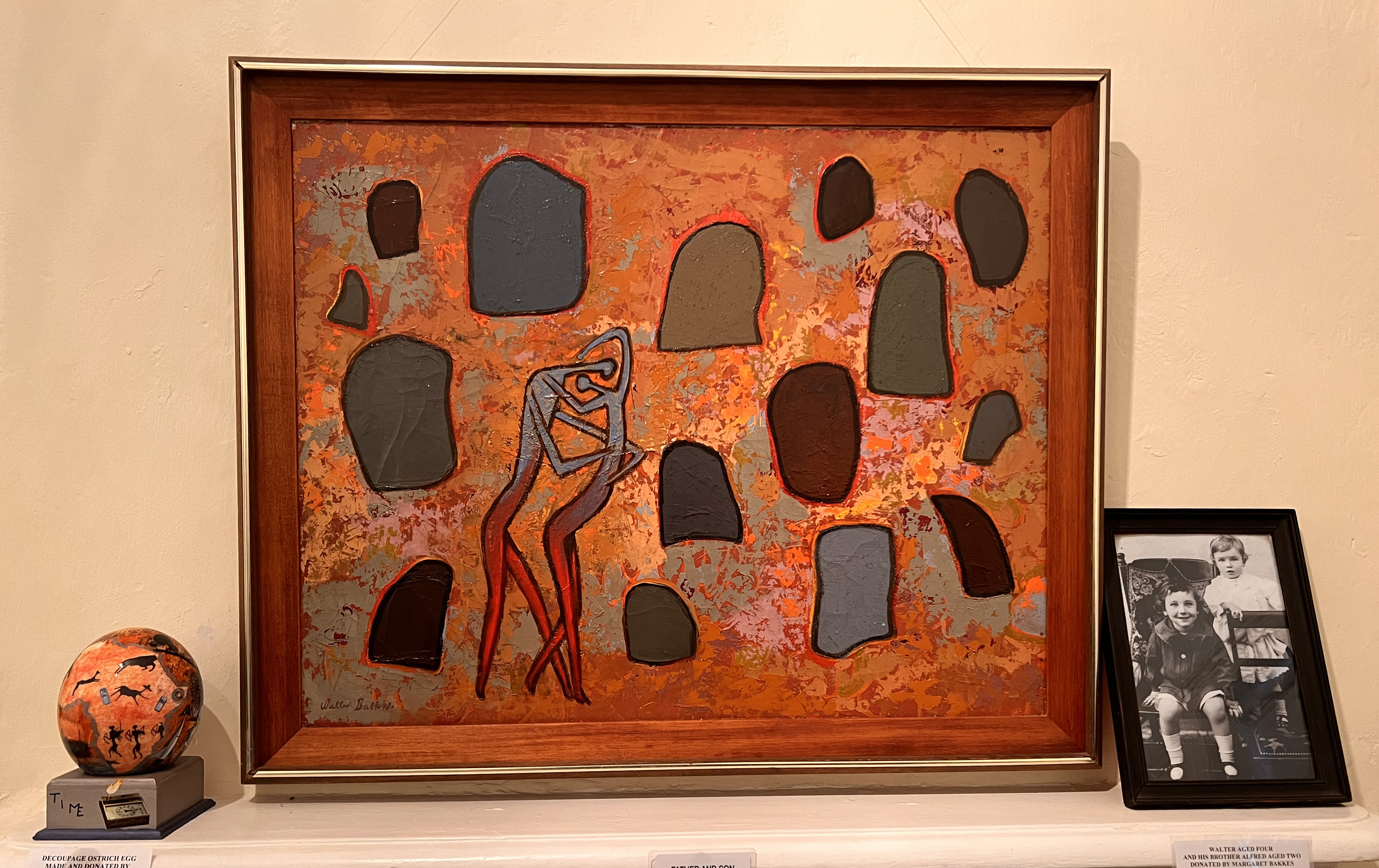
Father and Son in the Rocks (1949). (Photo: Tony Jackman)
The work defied the draconian odds to become the jewel in the crown of the Walter Battiss Art Museum collection in Somerset East, where feisty Ros Turner proudly shows it off. Father and Son in the Rocks is a testament to the longevity of art and its patient ability to bide its time and ultimately transcend the chokehold of the bigots.
It is especially valued for its depiction of rock art and prehistoric rock shelters and for what Ros Turner calls “its place in the development of the abstract art of Walter Battiss”. His earlier more realistic work had taken a turn to the abstract around 1940 and, after meeting Pablo Picasso and Gino Severini in 1949, their influence became evident in his work.
But, despite the joyful use of colour and form in much of his painting, it’s in an upstairs room where his watercolours are displayed that my jaw dropped. You don’t really expect that of watercolours, but his are translucent. Alive. They transcend the palette. Turner explained that he used two palettes for his watercolours, “one to muddy the colour and one where he keeps the colours separate; that’s how he gets the bright colours”. Gets, not got. She talks about him as if he’s present.
Could these be scenes from Fook Island?…
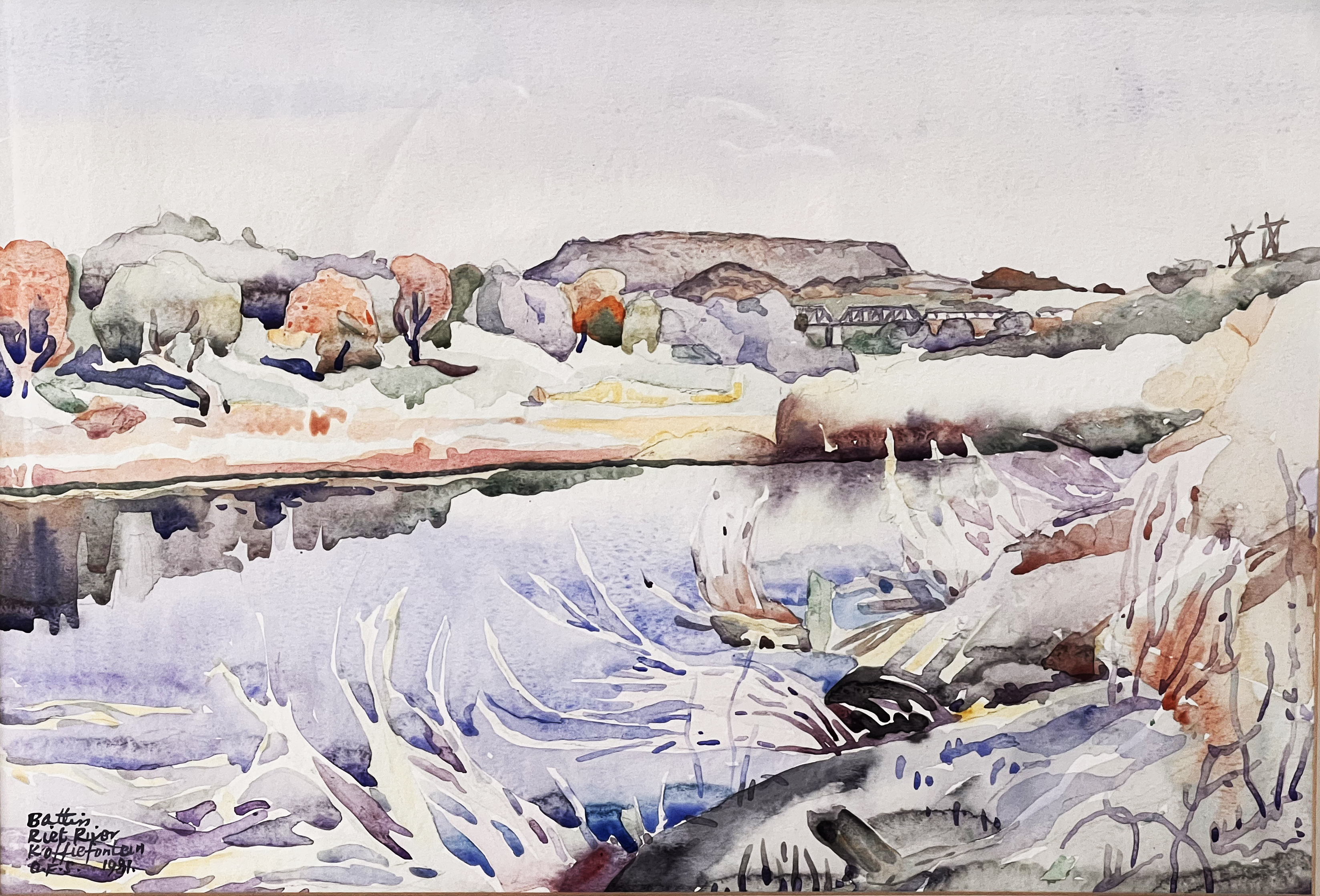
Above and below: Two of the magnificent watercolours by Walter Battiss that hang in an upstairs room of the Walter Battiss Museum in Somerset East. (Photo: Tony Jackman)
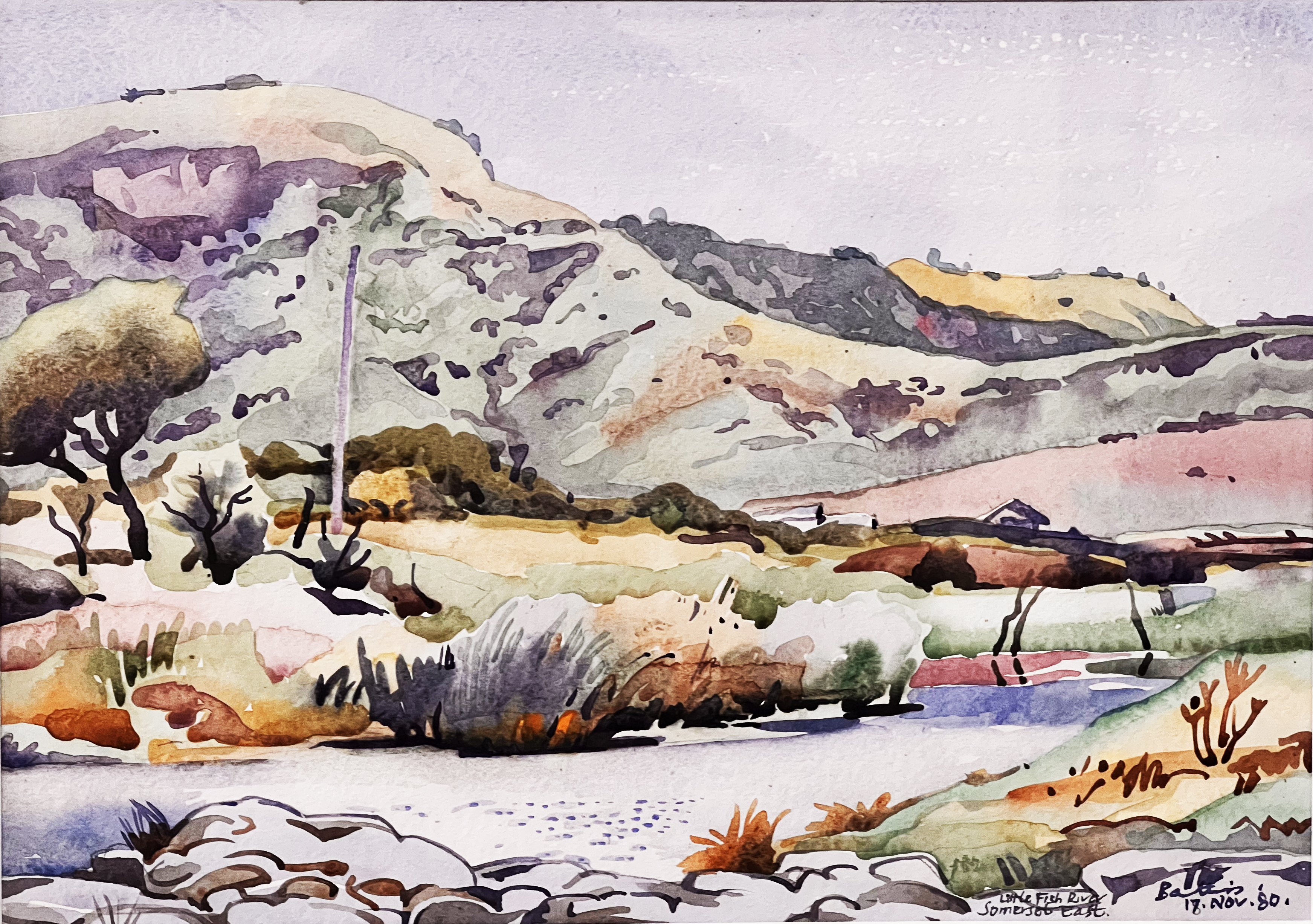 I made the rookie mistake of asking Turner if all of his art (other than in private collections) was on display here. She quickly put me right. “No, no, no. We have a lot of his art here, his friend Murray Schoonraad helped him to move it here. But definitely not all his art, he was prolific and he gave his art away. Most of his work is in Menlo Park, Pretoria.” Battiss had taught art at Pretoria Boys High for 30 years.
I made the rookie mistake of asking Turner if all of his art (other than in private collections) was on display here. She quickly put me right. “No, no, no. We have a lot of his art here, his friend Murray Schoonraad helped him to move it here. But definitely not all his art, he was prolific and he gave his art away. Most of his work is in Menlo Park, Pretoria.” Battiss had taught art at Pretoria Boys High for 30 years.
Climbing the narrow wooden stairs to the wonders above, Turner relates the story of officers with their spurs scuffing the steps as they trotted up, which seems unlikely if not impossible. And stories of a ghost of an English officer on the stairs and how someone once said the ghost threw a horseshoe at their grandmother. It doesn’t seem at all outlandish; it’s just the sort of house where ghosts would linger, and they’d need to get up and down, spurs or not. “I found the correspondence relating to these stairs. They spent R20,000 to have them rebuilt,” she tells me.

The ghostly stairwell. (Photo: Tony Jackman)
There are other tales of intrigue and strangeness. The architect in charge of restoration said the yellowwood floors came from the Boschberg where, in the 1800s, one of the explorers said he saw a cave painting of a one-horned animal, and there was a rumour that there was a unicorn living in the Boschberg. It was also believed that there were giant snakes in those green mountains.
But there’s a more serious side to the museum. They need help. They need funds for maintenance, to keep it going.
“The Walter Battiss Foundation was set up and we are looking for corporate funding,” said Turner. Things had been going quite well, the museum was attracting visitors, “but Covid put paid to that. Then of course the lockdown had an impact on us because people on road trips used to come to see us”. Foot traffic ground to a halt and Turner spent her lockdown making the Foodie’s Wife’s microwave chocolate cake and sitting it out. “Now that people are travelling again we’re seeing more visitors.” (But she still makes the cake.)
“We had a budget from the municipality for tourism for the first couple of years but that has fallen away (along with the funding of festivals). We try to keep tourism going ourselves and I’m doing the Facebook stories for the museum.” (Her stories make good reading.) If you’d like to help or know of an organisation that might, all the relevant links are at the bottom of the story.
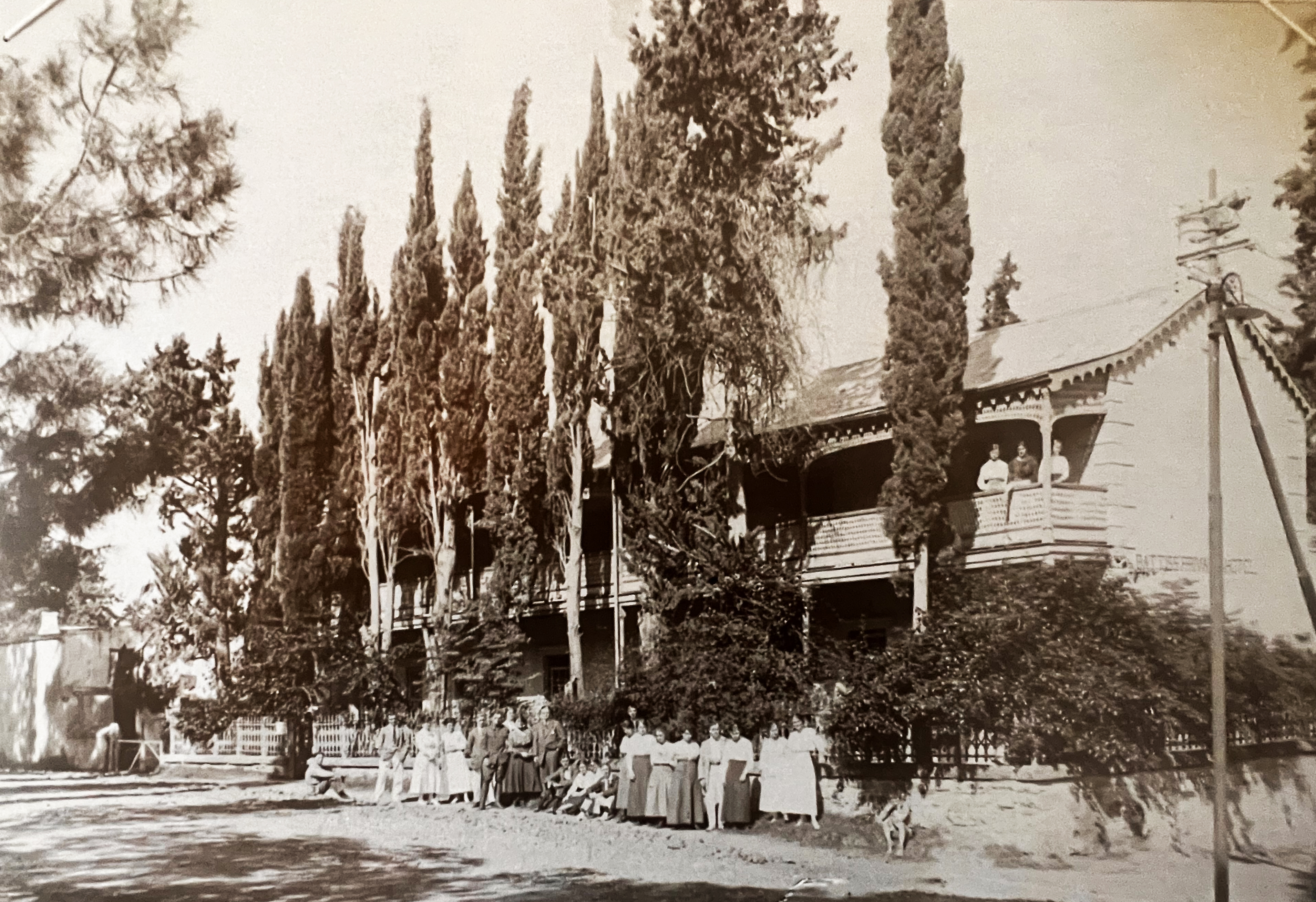
The Battiss Private Hotel, circa 1914 or thereabouts. The little boy on the kerb in the right foreground is believed to be the young Battiss. (Photo: Tony Jackman)
The family who ran the museum in earlier days had “looked after the art, but it was stuffed away and I pulled it out”, says Turner, the curator who loves her charges; and that means every one of the works in the museum. Okay, there may be one or two exceptions, by other artists. But let’s quickly skip past that. “Perhaps one day someone will come along and curate it all properly,” she adds.
“They used to say Battiss was a copycat, but not any more,” Turner says with firm jaw indicating how strongly she means it. I find myself a Battiss convert.
When you do visit Somerset East, make the time for a little foray to Fook Island which, and you may not have known this, is in the Karoo, just as it is anywhere and everywhere you might hope it to be. Quite where in the Karoo is for your imagination to find out. If I were you, I’d start in Somerset East. You can arrive with rands or dollars. My fellow Fookian, Ros Turner, will be happy to convert them to Fookian aks for you. DM/TGIFood
Contact Ros Turner at the Walter Battiss Art Museum, 45 Paulet Street, Somerset East on 042 243 1448 or 073 698 6539.
Walter Battiss Art Museum on Facebook
Walter Battiss Foundation on Facebook
Read more about Walter Battiss here and buy his certified prints.





 Become an Insider
Become an Insider
Comments - Please login in order to comment.